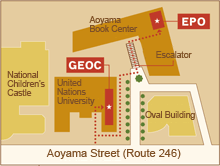Satoyama and satoumi landscapes are socio-ecological systems in Japan which have been shaped by centuries of interaction between locally-specific activities and lifestyles and a rich natural environment. At the same time, they represent irreplaceable cultural landscapes, intimately linked with the identity of the Japanese people, and important regional assets that need to be safeguarded for future generations.
However, satoyama and satoumi landscapes are now facing a crisis. During the last decades, widespread use of fossil fuel and chemical fertilizer has led to under-management of satoyama’s secondary forests. The decline of agriculture, forestry and fisheries has had negative impacts on the sustainable use of satoyama and satoumi landscapes.
A further challenge to the adequate management of these areas is the diminishing labor force, as a result of the ageing and depopulation processes affecting the Japanese countryside. As Japan’s population decline continues, the threats to satoyama and satoumi landscapes are expected to increase.
On the other hand, movements aimed at building a new society are rapidly gaining momentum. Japan’s 21st Century Environmental Nation Strategy, endorsed by the Cabinet in 2007, proposes a vision of sustainability that integrates three dimensions: a low-carbon society, a material-cycle society and a society in harmony with nature.
The transition to a sustainable society requires a careful balance between improved resource and energy efficiency, the development of new forms of renewable energy, progress on the three principles of reducing, reusing and recycling (3R), along with the conservation of biological diversity and sustainable use of natural resources.
By promoting the restoration and sustainable use of the rich biological resources that satoyama and satoumi landscapes possess, agriculture, forestry and fisheries have the potential to contribute not only to the realization of a society in harmony with nature, but also of a low-carbon and a material-cycle society.
To address the issues of population decrease and ageing, it is necessary to develop new regional-level management mechanisms that engage local governments, the private sector, NGOs/NPOs, urban residents and other actors in the sustainable use of satoyama and satoumi landscapes.
In addition, broad promotion of the values of these landscapes within Japan and overseas, coupled with the development of ecotourism and ‘green’ and ‘blue’ tourism that take advantage of their touristic resources and with improved acceptance of long-term residents, can play a core role in regional revitalization.
It is also important to establish effective partnerships with initiatives focusing on the conservation and restoration of satoyama and satoumi landscapes and of other secondary nature landscapes in Japan and around the world, and to share relevant experience and knowledge, as emphasized by the SATOYAMA Initiative, a global effort led by the United Nations University-Institute of Advanced Studies and the Ministry of the Environment of Japan.
The SATOYAMA Initiative collaborates with partners in Japan and worldwide, sharing approaches that draw on the values and wisdom associated with a diversity of ecosystem services, integrating traditional knowledge with modern science and exploring new forms of co-management, with the aim to build societies where humans and nature can coexist.
Developing of networks for sharing information and experiences and disseminating advanced initiatives through meaningful cooperation among regional policy makers both within Japan and worldwide is important for sustainable use of satoyama/satoumi landscapes and regional revitalization. Co-operation with International Partnership of SATOYAMA Initiative, which was launched on 19th October and a forum on cities and biodiversity, which will be established in conjunction with the 11th Meeting of the Conference of the Parties to the Convention on Biological Diversity (CBD/ COP11) to be held in India in 2012 as an activity of CBD Cities and Biodiversity initiative, will be effective for this purpose.
The formulation of a long-term strategy for the revitalization of satoyama and satoumi landscapes proposed at the Satoyama Governors’ Summit is expected to gain recognition, both within Japan and globally, as an approach that can make a major contribution to building a sustainable society and to local community development.
Download the full message of Satoyama Governors’ Summit (PDF 139KB)

















